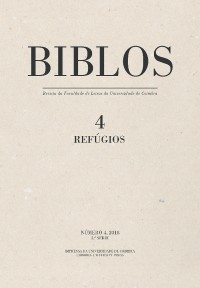Please use this identifier to cite or link to this item:
https://hdl.handle.net/10316.2/44876| DC Field | Value | Language |
|---|---|---|
| dc.contributor.author | Mangerona, Ricardo Afonso | - |
| dc.date.accessioned | 2018-12-28T12:41:25Z | |
| dc.date.accessioned | 2020-09-18T09:09:40Z | - |
| dc.date.available | 2018-12-28T12:41:25Z | |
| dc.date.available | 2020-09-18T09:09:40Z | - |
| dc.date.issued | 2018 | - |
| dc.identifier.issn | 0870-4112 | - |
| dc.identifier.issn | 2183-7139 (PDF) | - |
| dc.identifier.uri | https://hdl.handle.net/10316.2/44876 | - |
| dc.description.abstract | Analysing the main character’s nocturnal journey (in the seven chapters entitled “Night”), our goal is to draw attention to a process of reconstruction of reality that is similar to fictional creation. Based on both the protagonist's memory or affective memory and on fragments of factual reality, this process provides the main character, up to a certain point in the storyline, with a self-defense mechanism and a (night) shelter from the decaying reality (of the day). However, this mechanism is to be ultimately perverted by the same decay. This analysis will be based on Ricoeur’s concept of utopia as a compensatory distortion of reality, and on the classical example of Don Quixote, without nevertheless directing our reflection towards a comparative study. Finally, we will analyse the success and utility of this strategy as a means of validating an allegorical funtion in the dystopian novel. | eng |
| dc.description.abstract | Analisando o percurso nocturno (nos sete capítulos “Noite”) da protagonista, pretende-se mostrar como nele opera um processo de reconstrução do real próximo da criação ficcional. O processo, com base, a um tempo, na imaginação e memória afectiva da heroína e em fragmentos da realidade factual, proporciona-lhe, até certo momento da narrativa, um mecanismo de defesa e abrigo (nocturno) perante a realidade decadente (diurna), mas acaba por se perverter, também ele, contagiado pela mesma decadência. Partimos, para essa análise, do conceito ricoeuriano de utopia, enquanto deformação compensatória da realidade, e do exemplo clássico de D. Quixote, sem, contudo, orientar a reflexão num estudo de natureza comparativa. Conclui-se com a utilidade do engenho na validação alegórica da narrativa distópica. | por |
| dc.language.iso | por | - |
| dc.publisher | Imprensa da Universidade de Coimbra | - |
| dc.rights | open access | - |
| dc.subject | Margaret Atwood | eng |
| dc.subject | The Handmaid’s Tale | eng |
| dc.subject | Fiction | eng |
| dc.subject | Reality | eng |
| dc.subject | Dystopia | eng |
| dc.subject | Margaret Atwood | por |
| dc.subject | The Handmaid’s Tale | por |
| dc.subject | Ficção | por |
| dc.subject | Realidade | por |
| dc.subject | Distopia | por |
| dc.title | Nos escombros do real. A ficção como estratégia evasiva (na própria ficção): memória, imaginação e realidade no romance distópico de Margaret Atwood The Handmaid’s Tale (1985) | por |
| dc.title.alternative | Under the ruins of reality Fiction as an escaping strategy (within fictional itself) memory, imagination, and reality in Margaret Atwood’s distopic novel The Handmaid’s Tale (1985) | eng |
| dc.type | article | - |
| uc.publication.collection | Biblos nº 4, 3ª série | - |
| uc.publication.firstPage | 61 | - |
| uc.publication.issue | 4 | - |
| uc.publication.lastPage | 81 | - |
| uc.publication.location | Coimbra | - |
| uc.publication.journalTitle | Biblos | - |
| dc.identifier.doi | 10.14195/0870-4112_3-4_3 | - |
| uc.publication.digCollection | IP | - |
| uc.publication.digCollection | B1 | - |
| uc.publication.orderno | 3 | - |
| uc.publication.area | Artes e Humanidades | - |
| uc.publication.manifest | https://dl.uc.pt/json/iiif/10316.2/44876/217974/manifest?manifest=/json/iiif/10316.2/44876/217974/manifest | - |
| uc.publication.thumbnail | https://dl.uc.pt/retrieve/11286630 | - |
| uc.publication.parentItemId | 71708 | - |
| uc.itemId | 71712 | - |
| uc.thumbnail.uri | https://dl.uc.pt/iiif-imgsrv/11286585/dl!3!55!06!75!55067538173926762239215957648923868975 | - |
| item.fulltext | With Fulltext | - |
| item.grantfulltext | open | - |
| Appears in Collections: | Biblos | |
Files in This Item:
| File | Description | Size | Format | |
|---|---|---|---|---|
| nos_escombros_do_reala_ficcao_como_estrategiaevasiva__na_propria_ficcao_.pdf | 1.14 MB | Adobe PDF |  |
Items in DSpace are protected by copyright, with all rights reserved, unless otherwise indicated.
